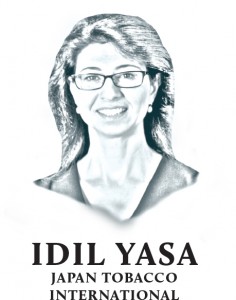Against the backdrop of the World Health Organization’s Anti-Tobacco Conference in November, we showcase the views of two opposing forces. In an article originally written for our sister publication India Business Law Journal, Japan Tobacco International’s Idil Yasa advocates stronger IP protection for brands. As a counterpoint, a former GC to the Australian Medical Association, Sarah Byrne, outlines why she believes her country’s tobacco plain packaging laws are not only right, but also innovative and effective.
AT THE END OF 2012, Australia introduced one of the most restrictive and extreme regulations ever proposed for fast-moving consumer goods: plain packaging for tobacco products.

is the branding ban vice-president at Japan Tobacco International.
Trademarks, logos, non-prescribed colours and graphics have been banned with only the use of the brand name permitted in a standard font and size. Graphic health warnings now cover 90% of the back of packs and 75% of the front. Put simply, the measure is a branding ban; manufacturers of a legal product are no longer allowed to use branding on the packaging of their products.
Trademarks represent a bond of trust between manufacturer and consumer; a reassurance of quality. They ensure consumers can make informed choices and buy with confidence. Understandably, following many years of investment, tobacco trademarks are extremely valuable, running into billions of dollars.
Protection of intellectual property (IP) is an essential element of an open, free and dynamic economy. Investors, both domestic and international, can only commit to projects with confidence if they can be sure that their IP is protected. Strong IP protection makes it clear that a country is open for business. This is supported by a number of studies that have shown a clear link between a country’s economic performance and its level of IP protection.
It was with a complete misunderstanding of the role and value of brands and trademarks that Australia decided to introduce its branding ban. Quite simply, packaging is not advertising and cigarette packaging does not prompt people to start smoking. Years of research into the causes of smoking uptake support this.
Australia’s branding ban has been a complete failure. After more than three years, we have seen no change in the rate of decline in smoking.
Before the branding ban was introduced, supporters of the measure claimed it would have an instant effect but, after this failed to materialize, policymakers shifted the goal posts. It was later claimed that the branding ban was never meant to prevent current smokers from smoking, but would instead have an effect in the long-term. The Australian government has been desperately trying to present the policy as a success out of fear of international embarrassment over its failure.
Although the branding ban has not accelerated the decline in smoking levels, it has had a dramatic impact on market dynamics in Australia. In an environment where all tobacco packs look the same, price has become the main driver of choice and smokers are increasingly opting for cheaper cigarettes. Accompanying this “down trading” we have seen an increase in illegal sales as consumers look for the cheapest products – even if this means turning to the black market. Illegal cigarette sales impact government revenue and are an important source of funding for terrorist and criminal organizations around the world.
The attack on branding is a direct attack on the principle of quality. With key quality signals removed from tobacco packs, there has been a corresponding impact on the margins that premium price tobacco products deliver for manufacturers, wholesalers and retailers. Furthermore, in a heavily commoditized environment, smaller share products are being withdrawn from the market, resulting in a loss of choice for consumers.
An increasing number of countries around the world are opposed to branding bans, often citing the lack of evidence and the worrying impact on IP rights. Indonesia, the Dominican Republic, Honduras and Cuba are challenging Australia’s branding ban at the World Trade Organization (WTO), and a WTO panel ruling is expected to be published in 2017.

The four countries, and others supporting them, claim that the branding ban is a violation of two agreements administered by the WTO, namely, the Agreement on Trade-Related Aspects of Intellectual Property Rights, and the Agreement on Technical Barriers to Trade. They argue that the legislation violates the rights of trademark owners and unjustifiably encumbers the use of trademarks in the course of trade, and that the legislation is more trade restrictive than necessary to fulfil its purported objective. Still, some European countries are following Australia’s example and will introduce branding bans this year or the next. The governments of some Asian countries have also shown an interest in considering the policy, including Singapore, which recently held a consultation.
The WTO could potentially rule that brand owners have a right to use their trademarks, and that Australia’s branding ban is illegal. However, if Australia’s legislation is upheld, a worrying precedent will be set for other industries. Already we have seen a UK parliamentary committee consider the introduction of plain packaging for alcoholic beverages, and Indonesia has threatened to retaliate against Australia with plain packaging for wine.
So what is the main driver of this extreme regulation?
You must be a
subscribersubscribersubscribersubscriber
to read this content, please
subscribesubscribesubscribesubscribe
today.
For group subscribers, please click here to access.
Interested in group subscription? Please contact us.
























